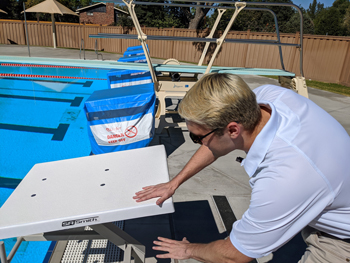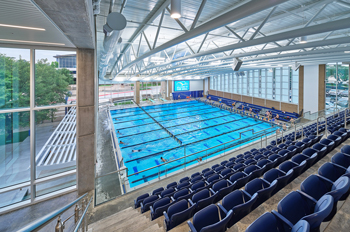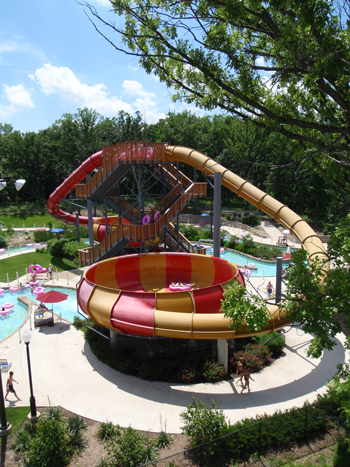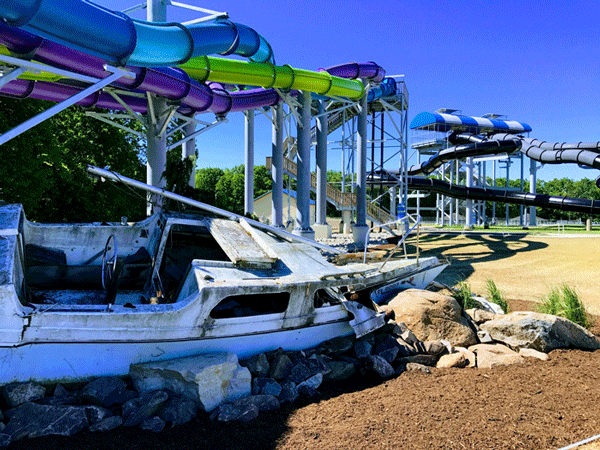So, what is it that keeps aquatic facility operators awake at night? I’d guess one safe bet would be water quality. And of course, there’s many variables involved with keeping a pool’s water safe, clean and clear, including keeping a lot of mechanical systems working properly. No doubt the people who maintain these systems have their work cut out since achieving ideal water chemistry is a never-ending job. But there are also many other considerations to be vigilant of, from making sure pool structures and decks are sound to keeping waterslides operating safely to making sure things like pool ladders and drain covers are properly secured.
Arlington Heights, Ill., is very proud of their aquatic offerings, maintaining five outdoor pools and an indoor facility with four bodies of water. Jennifer Rogers is superintendent of trades at the Arlington Heights Park District, and her team handles pool maintenance. She shared a few of the daily tasks they perform, which of course included regular checks of the pool chemistry. “The pool management staff and lifeguards should also be checking before opening and then hourly. The pool maintenance staff also check their chemical levels in the tanks so they know if they need to re-order anything, and they perform a visual/audio check in the pool filter rooms to make sure everything is operating as it should.”
In addition to a long list of daily tasks, there are, of course, items to address weekly, monthly, quarterly and seasonally. “Weekly the staff add bicarbonate to help with alkalinity,” said Rogers. “Backwashing of the pool filter systems is done approximately every month. Staff also clean probes and sensors, and add (a sequestering agent) treatment for the indoor pool cast iron pipes monthly.”
Of course, there are also basic pool features like ladders and railings, and amenities such as slides, dives and pool lifts. “These items are checked weekly and the aquatic staff are also good at calling if there is a concern.” Indeed, it’s important that all pool staff keep a critical eye on the details as an extra level of vigilance.

In Crown Point, Ind., the impressive Deep River Waterpark is operated by Lake County Parks. There are many amenities, including a giant multi-lane mat slide, a speed slide where users free fall at speeds up to 35 mph and an enclosed triple tube slide that’s five stories high. There are two lazy rivers, a 500,000-gallon wave pool and a water play area for little ones with two levels of water activities. In other words, lots to look after!
Each morning at Deep River, the various departments all have a checklist/inspection sheet of things that get looked at before opening for the day, according to Chris Nawracaj, general manager of the park. “Water Safety makes sure the pools are clean, slide tower stairs are clean, grates at tops of slides are attached and all of their safety equipment is in place and ready to use. Food and Beverage checks all food areas, making sure everything is clean, safe, stocked and ready to go. Our parks services team checks all the bathrooms and grounds, making sure that everything is clean and ready to go for the day.”
In addition to the different daily inspections, there are also more in-depth weekly inspections that get performed by a rotating group of employees, said Nawracaj. “These inspections are more detailed in nature and involve things such as making sure stadium lighting is working, all fire extinguishers are in place and charged, all the slide flumes and ride paths are free and clear as well as making sure there are no issues with the fiberglass.”
In recent years, more community and recreation pools have been adding larger waterpark-type features, which means more education and maintenance is necessary. Nawracaj confirmed that there are a lot of components to many of the rides that require “constant upkeep to maintain the attractions. The pool environment isn’t always the easiest on equipment either, especially when you are using chlorine and acid.”
He said that as with everything, they handle what they can in-house and outsource the rest, if necessary. “If it’s something that involves the slides or fiberglass, we’ll always leave that to the professionals.”
Air & Water
Water treatment is at the core of any aquatic facility, and filtration is a key element of water treatment. One type of filtration system that’s become very popular in recent years is the regenerative media filter (RMF). Neal Hershey works in product management at the Warwick, R.I., branch of a provider of water treatment solutions, and he feels that the intensity level of commercial pool maintenance is usually linked directly to bather loads. “Busier pools require more operational maintenance and usually demand high water quality standards.”
He said RMFs excel in this area by regenerating the filter media daily. “Traditional sand filters require backwashing a couple times a week to clean dirty filters,” said Hershey. “By regenerating the media daily, the (RMF) only uses water during a media change,” which he said is about once a month on average, though “pools with lower bather loads might go months without needing to recharge the perlite.”
During a media change, only a couple of filter tank volumes of water are used, so the water savings when compared to sand filters can be significant. Since the RMF is using less water, “there is also significant ongoing savings seen in chemical and energy costs due to not having to reheat and retreat the water lost during backwashes with sand filters.”
But sand filters are still very popular, according to Hershey, and they offer them as well. “Most people like them due to the lack of moving parts and low-tech design of the system,” though he said they’re not great at removing microbiological contamination, pointing out that high-rate sand filters remove particles down to 20 to 30 microns, but cryptosporidium is about five microns in size. He said the RMF filters “can remove down to one-micron-sized particles and remove an average of 99% of five-micron-sized particles in a single pass. Sand filters also require a lot of water to backwash properly.”
“When we put in our new slide a couple years ago, it was our first pool with a regenerative media filter,” said Nawracaj. “So far, we’ve been beyond impressed with the performance as far as water clarity, along with the minimal amount of backwashing you would do with traditional sand filters.” He said this not only saves time, but also water and chemicals, which saves money. He said all their other filters are sand filters.
Rogers said, “We use regenerative pool filtration systems. We also put together a budget every year to address replacement or maintenance needs of things like pumps, valves, etc.”

When it comes to pool pumps, most pumps in larger commercial pools these days are being powered using variable frequency drives (VFDs), according to Hershey. “Usually anything above a five HP pump would benefit from having a VFD connected to it.”
He said that pumps should also have strainers for protection. “Think of this as the first line of defense for the pump impeller and the filter system as well. All the larger debris should be captured at the strainer and may require daily cleaning in high-use situations.” He said things like Band-Aids, hair ties and swim goggle parts are frequently found in strainer baskets.
Air quality, humidity and chloramines are of course big considerations for those overseeing indoor pool systems. “Medium-pressure UV is a great choice for managing combined chlorine in an indoor facility,” said Hershey. “Maintaining good water chemistry balance is also a key factor to consider when looking at high bather load applications.”
Rogers said their indoor pools have UV as a secondary disinfection system, and “we have good quality pool dehumidification units that help with air quality in the indoor pool areas.”
UV systems can also benefit outdoor pools. “We’ve found that UV has been a big help on our older pools,” said Nawracaj. “While something that is probably standard on any new build, adding it to our original pools that didn’t have it has really helped us maintain better chemical balance.”
Chemical controllers have become standard these days, and Rogers and Nawracaj both confirmed that their facilities utilize these. “We’ve found that they help us immensely in understanding what’s happening in our pools throughout the day,” said Nawracaj.
Hershey said these controllers are essential to maintaining a proper water balance. “Cleaning the probes once a month, following the manufacturer’s recommendations for calibration and having spare parts on hand will go a long way to ensuring consistent chemical dosing. Sample stream timing and properly sized chemical dosing equipment is just as important to ensure the water chemistry controller is able to keep up with demanding bather load situations.”
Keeping a Record
Counsilman-Hunsaker, an aquatic planning, design and consulting firm, offers consultation with regard to facility operations, including maintenance strategies and procedures, and they offer facility audits, to look at a venue’s operations and see where improvements might be achieved.
“We’ll look to see if they have a maintenance plan put together, what sort of maintenance procedures they do, what they’re checking on a daily, weekly, monthly, quarterly basis,” said Miklos Valdez, studio director at Counsilman-Hunsaker.
He said they’ll help devise a facility’s plan as part of their design process, dependent on the type of pool, the mechanical equipment, the types of chemicals they’re using, etc., and added that they can get a good idea of what someone’s maintenance procedures are at existing facilities by looking at their documentation. “If everything looks neatly documented and they’ve got that all in place, then more than likely they’ve got a pretty good maintenance plan. And if they haven’t been documenting things, then usually it’s kind of hit or miss.”
Valdez’ company offers an app that aids with operational issues such as daily checklists, staff certifications, team performance, pool test tracking and more. There are different versions of the documentation system, including one focusing on facility operations, which covers a lot of the maintenance considerations.
Valdez said they’re hoping the industry continues to move toward documenting things digitally and not on paper. He shared a conversation he’d had with someone at a conference who had recently taken over several facilities, and whose predecessor didn’t keep good records. “She had no clue where any of the previous records were. When you’re looking for historical data on what you’ve been fixing, what you’ve been replacing, it helps to really know where all that stuff is, and you have a deficit if you don’t.
“When you’re recording things digitally, you can report a lot better, so you can more easily see trends in maintenance,” he continued. “For instance, if you’re having to replace a chemical feed line every month, maybe instead of waiting for that feed to break you replace it every three weeks or something, so you replace it before it breaks and fails on you and you’ve got a chemical spill.”
Open and Close
Aside from air quality issues, when it comes to indoor versus outdoor pool maintenance, Valdez said the biggest thing is startup and closedown procedures, since indoor pools typically aren’t having to drain their pools and winterize everything. But then indoor pools also don’t have that downtime to work on larger repairs and maintenance. “Pool staff perform pool filter maintenance in the off-season, including degreasing and replacing filter elements, as well as turning the pool pumps weekly to keep them from seizing,” said Rogers. “They rebuild all of their pumps and other equipment. And our electricians go through all the electrical components of each pool facility to address any repairs needed before the season.” Staff also refinish slides and water features.

Nawracaj said they have closing checklists, mainly consisting of making sure all the pools are drained properly and all the valves that need to be open to prevent freezing are open, as well as making sure everything gets put away and stored properly. And since they’re in a cold climate, “we also have to make sure we blow out some of our buildings that don’t have heat in the winter.
“When it comes to maintenance tasks, it’s an ongoing list of items that need repair, especially at a park that’s approaching 30 years old.”
He said in the off-season they tackle major projects from adding cabanas to rebuilding aging mechanical components. “Being a parks department with a limited budget, we always try to do what we can in-house.”
He said pool painting gets rotated. “In the pre-season the pools all get power-washed and cleaned and we’ll make decisions from there what needs to be painted based upon need. It’s generally handled in-house unless it’s something like a slide tower that needs sand-blasting before being painted.”
Rogers said they also handle their painting in-house, which includes acid washing and power washing. “We paint each pool approximately every three years based on pool paint and concrete condition.”
For indoor pool decks, she said they use a walk-behind floor scrubber weekly and power wash as needed. And they utilize pool vacuums. “The trades’ staff do trainings with the aquatic staff so that they have a better understanding of how to use the equipment that we have to clean the pools.”
Get Some Guidance
Valdez explained that they look to the Model Aquatic Health Code (MAHC) for a lot of their standards and what they’re checking on a daily, weekly and monthly basis. “Even if that state’s standards are a little more lax than the MAHC, whenever possible we try to design and we try to operate according to MAHC.”
In fact, Valdez had just done a presentation at this year’s Association of Aquatic Professionals (AOAP) conference about the MAHC and maintenance. He pointed to their latest updated edition, containing “everything that’s needed in a maintenance plan. It goes into inspections, regular maintenance, placement of components, what kind of documentation you need, equipment inventory, manuals and everything.”
Within the pool industry, Valdez said they strive to get everyone who’s maintaining a pool to be certified. His company offers pool operator certifications, giving a baseline for “keeping good water quality, maintaining your pool and troubleshooting. Beyond that you really have to educate yourself as far as what does the MAHC say, what does your specific jurisdiction say about chemical levels and testing frequency and documentation,” which varies from state to state.
Other groups like the Pool & Hot Tub Alliance (PHTA) also offer different certification programs for pool maintenance specialists, operators, technicians and service professionals.
“Our pool maintenance staff are all Certified Pool Operators (CPO), and we have a good budget for training,” said Rogers. “They have attended training on pumps, resurfacing of the pools, lockout/tagout, confined spaces and other safety topics.”
Nawracaj said they’ll network with other parks and help out their facilities when they reach out with questions. “We’re members of the IAAPA (International Association of Amusement Parks and Attractions) as well as WWA (World Waterpark Association) and attend those shows regularly as well as volunteer by serving on various committees with those organizations.”
Rogers said there are many challenges to maintaining all their pools, including having adequate staffing with the appropriate experience, the time needed to get them open in the spring, unexpected daily operation or maintenance challenges, annual maintenance and the financial aspect of operating pools.
“However, with the challenge of operating pools comes the opportunity to provide a service to a water-loving community that appreciates the pools. It’s rewarding for us all to see the use of the pools and the enjoyment they bring to the public.” RM



